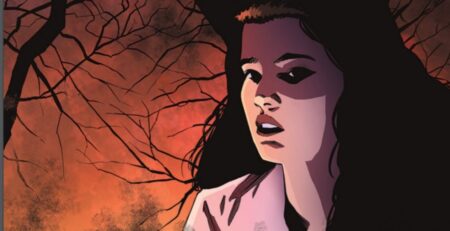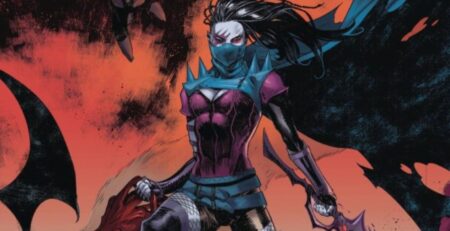
The Boy Who Conquered A Mountain is written and created by Jonathan Chance with artwork, colors, and lettering by Emilio Utera. It is published by Heavy Metal Publishing under the Virus imprint. Young Kaleb trains to join the Rising Sun ninja clan while being plagued by ominous nightmares and his own insecurities. His nightmares become a reality when a massive dragon attacks his village, leaving it in flaming ruins. With his trusted horse and words of encouragement from his grandfather, Kaleb goes on a quest to slay the dragon and rescue potential survivors from his village.
The concept of a young warrior pitted against a dragon has been tackled in various stories across the years. From Saint George and the Dragon to Prince Phillip battling Maleficent in her dragon form in Sleeping Beauty, the imagery of a warrior armed with nothing but a blade and his courage against a massive fire-breathing reptile is a sight to behold. Chance and Utera put their own spin on things by setting their tale in feudal Japan; instead of the armor of a shining knight, Kaleb dons the blood-red armor of a fallen samurai and wields a katana instead of a broadsword. The dragon itself is very different from what you’d normally associate with a dragon. It has multiple spider-like legs, and its gaze turns its victims to stone; its inhuman design also brings the Jabberwock from Alice in Wonderland to mind.
Utera’s artwork, which is the highlight of the graphic novel, also does a great job of building up the menace of the dragon. At first, readers won’t see much of the dragon except its soulless white eyes and massive clawed limbs; this has the Jurassic Park effect of building up suspense and making the dragon’s full appearance all the more shocking. Utera also draws ninja of all shapes and sizes, as Kaleb is far shorter and less muscular than his fellow Rising Sun ninja. Also serving as the graphic novel’s colorist and letterer, Utera brings a stunning range of environments to the table. When the dragon attacks the village, the sky is awash in fiery orange swirls of flame. The days feature an eerily cold blue sky, with the ash from the dragon’s breath creating a dark grey coat on the ground.
Storywise, Chance delves deep into Kaleb’s head and lays bare his fears and hopes. He is belittled by his fellow ninja, who believe he isn’t up to the task of joining the Rising Sun. And he is confused as to what his dreams mean. Yet throughout his journey, he finds the resilience to save his fellow villagers and enacts a plan to take down the dragon. And at the end, he takes up the mantle of leadership of the Rising Sun, resolving to rebuild from the ashes. Even if this is a story that’s been told before in many forms, the mixing of Japanese history and fantasy gives The Boy Who Conquered A Mountain a leg up over its predecessors.
The Boy Who Conquered A Mountain combines the classic hero’s journey with Japanese history and rich, detailed artwork for a unique tale that serves as a metaphor for conquering one’s fears. If you enjoyed Yasuke or Ghost of Tsushima, I recommend giving this book a read-it feels like a fairy tale I never got to read as a kid.
The Boy Who Conquered A Mountain is currently available to purchase from Heavy Metal.
The Boy Who Conquered A Mountain
TL;DR
The Boy Who Conquered A Mountain combines the classic hero’s journey with Japanese history and rich, detailed artwork for a unique tale that serves as a metaphor for conquering one’s fears. If you enjoyed Yasuke or Ghost of Tsushima, I recommend giving this book a read-it feels like a fairy tale I never got to read as a kid.







